Overview :
Yoga poses offer a gentle creation to the practice, focusing on constructing electricity, flexibility, and mindfulness. Starting with foundational poses like Mountain Pose, Downward-Facing Dog, and Child’s Pose, beginners can expand frame attention and alignment. Gradually progressing to poses like Warrior I and II enhances energy and balance. Each pose encourages deep breathing and aware movement, fostering a sense of calm and well-being. With consistent practice, beginners can experience improved flexibility, decreased pressure, and better universal health and vitality.
Yoga Poses for Beginners-Benefits
Yoga poses for beginners provide a large number of benefits, particularly for the ones new to the practice. They help improve flexibility, regularly easing muscle tissues and joints into deeper stretches. Beginners also broaden their strength as they hold poses, improving muscle tone and stability. Yoga poses promote better posture by aligning the backbone and strengthening core muscle mass. Moreover, they domesticate mindfulness and relaxation, reducing stress and tension tiers. Beginners experience stepped forward frame focus and balance, improving coordination and proprioception. As beginners progress, yoga poses foster an experience of empowerment and self-self belief, encouraging non-public growth and well-being on and off the mat.
14 Types of Yoga Poses for Beginners
Experts advise you to do yoga for breast firmness as various yoga postures help improve posture, revive bone joints, and good physic.
1. The Warrior Pose-Virabhadrasana
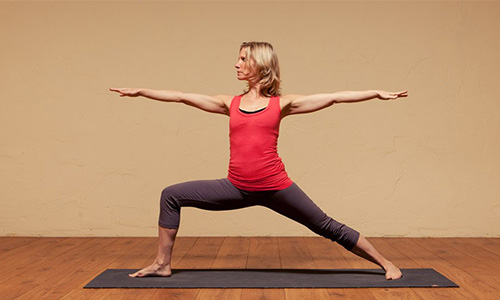
Uses: This standing yoga pose enhances thorax extension, flexibility, blood circulation, and lung capacity by enhancing lung capacity.
How to do :
- Keep your feet wide apart and parallel to each other
- Turn your left foot to the left 90 degrees and your right foot inside
- Breathe out and bend your left knee while keeping your right leg erect
- Raise your arms and align them with your shoulders
- Turn your head left to look at your arms
- Repeat it 10 times on each side
2. The Triangle Pose-Trikonasana
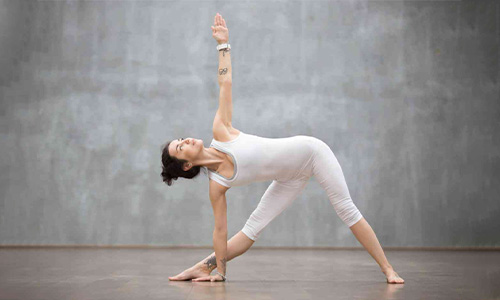
Uses: This asana stretches the thorax, vertebral column, knee, hip, thigh, inguinal region, hamstring, calf, ankle, and shoulder. It stretches the spine and improves blood flow.
How to do :
- Keep your feet shoulder-width apart
- Turn the left foot 90 degrees and the right foot 15 degrees
- Touch your left ankle with your left hand and stretch your right arm upwards
- Keep your arms, knees, and spine straight
- Turn your face up and look at your fingers
- Repeat with the other side
3. The Cobra Pose-Bhujangasana
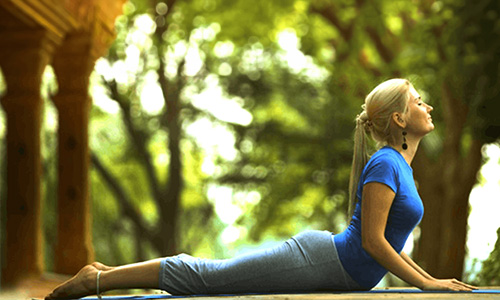
Uses: It stretches your shoulders, thorax, lungs, and abdomen. It increases lung volume and improves posture.
How to do :
- Lie on your stomach and inhale deeply
- Slowly raise your torso while resting your body on the floor
- Raise your head and look up
- Slowly breathe out and bring your torso down while looking down
- Gradually increase the time you stay in a cobra pose
- Gradually increase the repetition of this pose
4. The Bow Pose- Dhanurasana
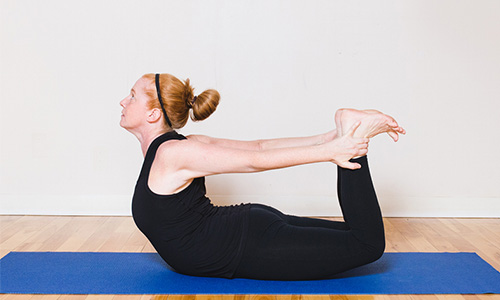
Uses: Back bending asana is a yoga practice that strengthens the spine, stretches the torso, abdomen, throat, and front, improves posture, and strengthens the chest region.
How to do :
- Lie on your stomach while breathing out slowly. Bend your knees and raise them behind your back
- Bring your feet together to your back bending your knee so that you can hold your ankles with your hands
- Slowly breathe out and pull your legs and arms upwards as far as you can
- Lift your hips and breasts from the floor
- Balance your body on your stomach
- Hold this position for 30 seconds
5. The Wheel Pose-Chakrasana
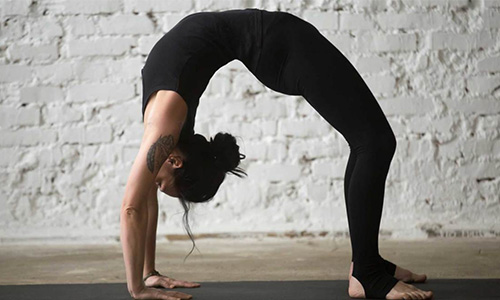
Uses: It’s otherwise called bridge pose. It strengthens the Buttocks, Vertebral column, Abdomen, Back, Leg, Wrist, and Arm. It stretches Thorax, Abdomen, and lungs. The wheel pose is one of the best yoga poses for lower back pain as well as chest muscles.
How to do :
- Lie down on your back, place your feet a bit more than shoulder-width apart
- Bring your feet to touch your buttocks while bending your knees
- Put your hands behind your head. Palms down on the floor with your fingers pointing your back
- Breath out and raise your breasts and hips as high as you can
- Straighten your arms to aid your body to stay in that position
- Hold it for 30 seconds
6. The Camel Pose – Ushtrasana
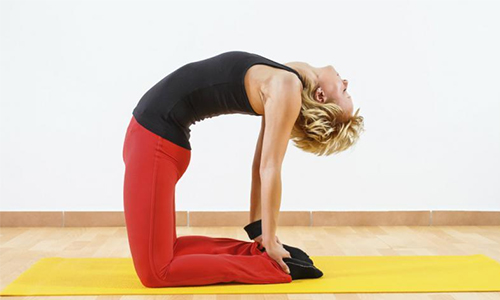
Uses: This pose stretches the thorax, abdomen, inner region, and thigh, increases lung volume, strengthens the thorax, and expands and strengthens the shoulders.
How to do :
- Stand on your knees and pull your feet together
- Slowly bend backward and your hands on your heels
- Arch your back and stretch your ribs
- Pull your head to the floor
- Hold this position for 30 seconds
7. Mountain Pose (Tadasana)
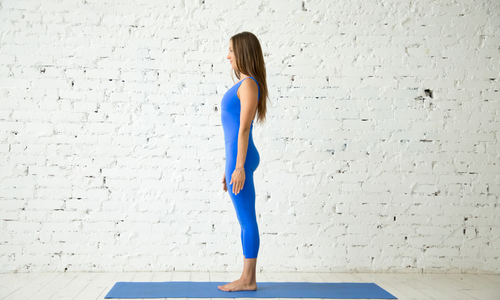
Uses: It improves posture, strengthens thighs and ankles, and increases awareness of the body’s alignment.
How to do :
- Stand tall with feet hip-width apart,
- arms by your sides,
- palms facing forward
- Engage thigh muscles
- lift the chest
- Relax the shoulders.
8. Downward-Facing Dog (Adho Mukha Svanasana)
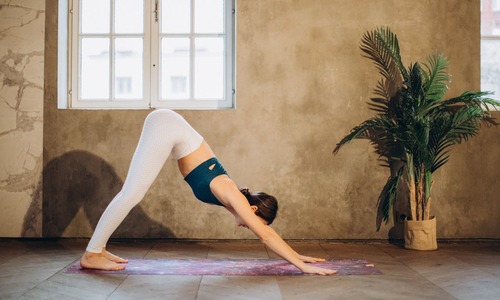
Uses: Stretches the hamstrings, calves, shoulders, and spine while strengthening the arms and legs.
How to do:
- Start on your hands and knees,
- Lift your hips toward the ceiling,
- Forming an inverted V shape.
- Press hands firmly into the mat,
- Relax the head, and lengthen the spine
9. Child’s Pose (Balasana)
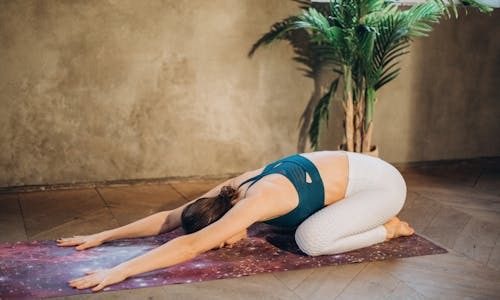
Uses: Promotes relaxation, stretches the hips, thighs, and ankles, and relieves back and neck pain.
How to do:
- Kneel on the mat
- Sit back on your heels
- Extend your arms forward
- Resting your forehead on the mat
10. Cat-Cow Pose (Marjaryasana-Bitilasana)
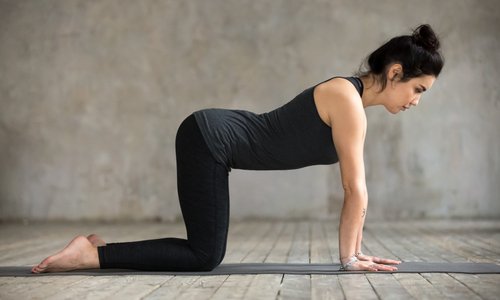
Uses: Improves spinal flexibility, massages the spine, and increases circulation to the vertebral column.
How to do:
1. Begin on your hands and knees
2. Inhale as you arch your back and lift your head (Cow Pose)
3. Exhale as you round your spine
4. Tuck your chin to your chest (Cat Pose)
11. Bridge Pose (Setu Bandhasana)
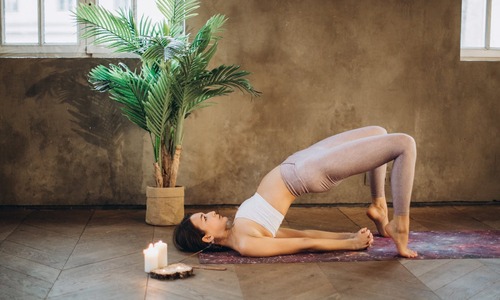
Uses: Strengthens the back, buttocks, and hamstrings, opens the chest and improves spinal flexibility.
How to do:
- Lie on your back with knees bent
- Feet hip-width apart
- Press into your feet to lift your hips toward the ceiling
- Keeping the shoulders grounded.
12. Corpse Pose (Savasana)
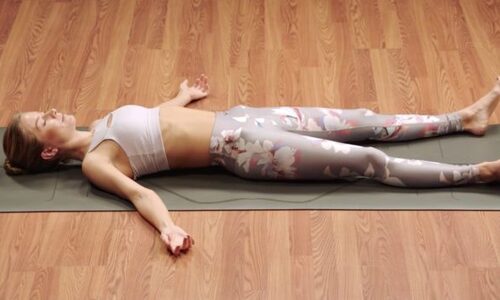
Uses: Promotes relaxation, reduces stress and anxiety, and allows the body to integrate the benefits of the yoga practice.
How to do:
- Lie on your back with arms by your sides
- palms facing up
- Close your eyes
- Relax the body completely
- Focus on deep, even breathing.
13. Chair Pose (Utkatasana)
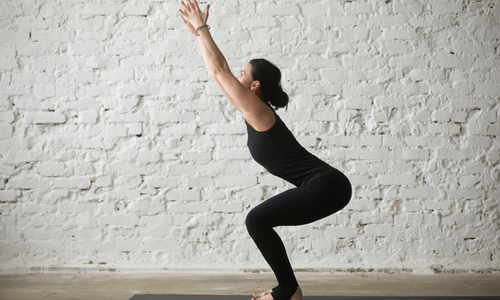
Uses: Strengthens the thighs, calves, and ankles, tones the core muscles, and improves posture.
How to do:
- Stand tall
- Feet together or hip-width apart
- Inhale as you raise your arms overhead
- Exhale as you bend your knees
- Lower into a squat position, as if sitting in an imaginary chair
14. Easy Pose (Sukhasana)
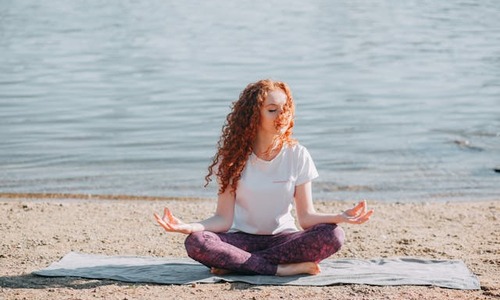
Uses: Promotes comfort and ease in seated meditation, stretches the hips, knees, and ankles, and calms the mind.
How to do:
- Sit on the mat with legs crossed
- Spine tall
- Hands resting on your knees or in your lap.
Yoga is a great way to improve the flexibility of joints and muscles. It improves muscle tone and strength. Yoga increases blood circulation and in turn, helps the body parts get more oxygen. It will help develop muscles underneath your breasts which will improve their shape while giving firmness naturally!
Related Blog: “5 Unusual Hobbies for Women”
FAQ :
- Which pose of yoga is best for beginners?
Best beginner yoga pose: Start with Mountain Pose (Tadasana) for grounding and body awareness. - Does yoga reduce belly fat?
Yoga helps reduce belly fat through regular practice, combined with a healthy diet and lifestyle. - Is 70 too old to start yoga?
Age 70 isn’t a barrier to starting yoga; it’s adaptable to all ages and fitness levels. - What is the first move in yoga?

